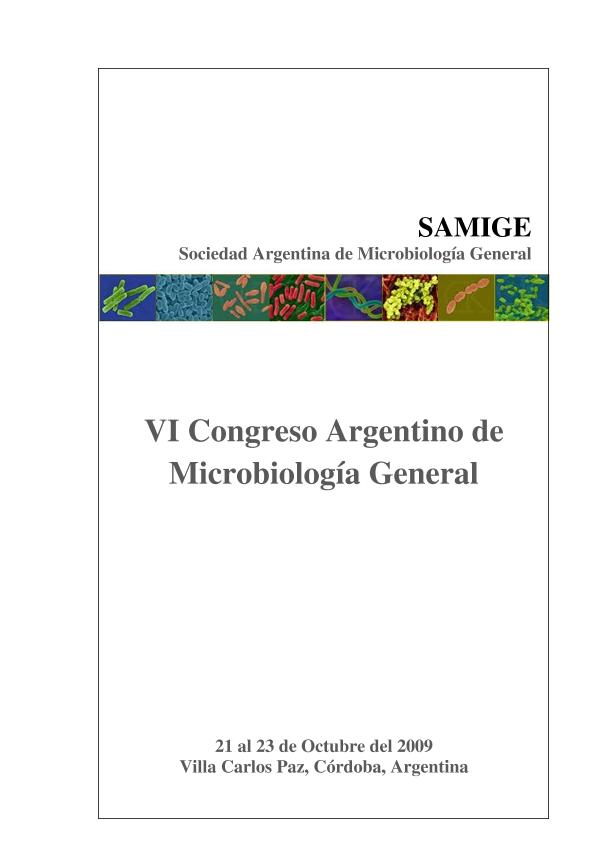Evento
Biocontrol of fungi from sour rot by volatiles produced by yeasts in table grapes
Nally, Maria Cristina ; Pesce, Virginia Mercedes
; Pesce, Virginia Mercedes ; Toro, Maria Eugenia; Castellanos, Lucia Ines
; Toro, Maria Eugenia; Castellanos, Lucia Ines ; Vazquez, Fabio
; Vazquez, Fabio
 ; Pesce, Virginia Mercedes
; Pesce, Virginia Mercedes ; Toro, Maria Eugenia; Castellanos, Lucia Ines
; Toro, Maria Eugenia; Castellanos, Lucia Ines ; Vazquez, Fabio
; Vazquez, Fabio
Tipo del evento:
Congreso
Nombre del evento:
VI Congreso Argentino de Microbiología General
Fecha del evento:
21/10/2009
Institución Organizadora:
Sociedad Argentina de Microbiología General;
Título del Libro:
Libro de resúmenes del VI Congreso Argentino de Microbiología General
Editorial:
Sociedad Argentina de Microbiología General
Idioma:
Español
Clasificación temática:
Resumen
Introduction: Sour rot is an important disease of grapes that affects both crop yield and wine quality. It is caused by a number of undesirable yeasts and bacteria, in association with fungi like Aspergillus, Penicillium and Rhizopus. Biocontrol of plant diseases with microbial antagonist has been developed as an alternative to fungicides. Objective: To evaluate the action of volatiles produced by wild enological yeast in biocontrol of fungi associated to sour rot disease of grapes. Material and Methods:a- Antagonist isolation: Yeasts were isolated from different sources such as healthy grapes, fermenting musts and enological environments.b-Fungi isolation: The pathogens were isolated from grapes berries with sour rot symptoms. c- Screening of antagonistic yeasts: In vitro, antagonism between fungi and yeasts was observed by placing both on the same Czapeck Agar plate and incubating at 25°C, for 5 days. Then, antagonist yeasts were evaluated in vivo: a wound at the equator of grapes berries was made. Aliquots (10 µl) of 106 CFU/ml yeast concentration followed by 10µl of fungal conidial suspension (10 4 CFU/ml) were seeded in the hole. d- Production of antifungal volatiles: Interaction tests consisted of the bottom part of a Petri- dish with the seeded yeast inverted on top of another bottom part containing a fungus, were sealed with Parafilm®, and incubated at 25°C. Fungal growth inhibition was determined when the diameter of the fungi decreased in comparison to the negative control. All experiments were repeated three times. Results: Aspergillus caelatus, A.carbonarius, A.versicolor, A.terreus, Penicillium comune, Rhizopus stolonifer and Ulocladium sp. were isolated. The screening in vitro of 234 isolated resulted in 95% of yeast with antagonistic activity and 63 isolates showed efficacy to inhibit the 7 grapes pathogens on in vitro test. From 63 isolates, 8 antagonist yeasts consistently produced antifungal volatiles, and inhibited mycelial growth of A.caelatus, A.carbonarius, A.terreus and P.comune. Volatiles produced by Kluyveromyces marxianus BKm153, Debaryomyces vanrijiae BDv197, Pichia guilliermondii BPg190, Saccharomyces cerevisiae BSc44 and BSc78 produced growth inhibition of A.terreus, although BKm153 showed the highest inhibition (48.66% ± 2.44). A.carbonarius was affected by the presence of volatiles produced by Candida sake BCs198, A.caelatus by S.cerevisiae BSc119 and P.comune by Candida versatilis BCv223. Conclusion: These results suggest that the production of antifungal volatiles from antagonistic yeasts play a significant role in mechanisms of biocontrol of fungal pathogens of grapes.
Palabras clave:
BIOCONTROL
,
FUNGI
,
SOUR ROT
Archivos asociados
Licencia
Identificadores
Colecciones
Eventos(PROIMI)
Eventos de PLANTA PILOTO DE PROC.IND.MICROBIOLOGICOS (I)
Eventos de PLANTA PILOTO DE PROC.IND.MICROBIOLOGICOS (I)
Citación
Biocontrol of fungi from sour rot by volatiles produced by yeasts in table grapes; VI Congreso Argentino de Microbiología General; Villa Carlos Paz; Argentina; 2009; 63-64
Compartir



